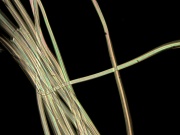Kodel
Description
[Eastman Chemical, TN] A registered trademark for a series of polyester staple and filament fibers. The original Kodel® fiber introduced in 1958 (now labeled as the 200 series) is a PCDT material prepared from dimethyl terephthalate and 1,4-cyclohexane dimethanol. Newer Kodel® fibers (400 series) are made from polyethylene terephthalate and have characteristics similar to Dacron®. The 200 series Kodel® fiber is a white and is easily dyed. It has good dimensional stability and wear resistance. Kodel® is used for carpets and easy care apparel. It is often blended with cotton to produce crease resistant garment fabrics. Kodel® is also used for fiberfill because it has good resilience and is nonallergenic.
Synonyms and Related Terms
polyester; PCDT; poly-1,4-cyclohexylene-dimethylene terephthalate
Risks
- Burns slowly and forms drops.
- Resistant to sunlight.
Physical and Chemical Properties
For 200 series:
- Insoluble in acids and alkali.
- May shrink in hot water and in chlorinated dry cleaning solvents.
- Fiber is smooth. Cross section is circular.
- Tenacity = 2.5-3.0 g/denier
- Elongation = 24-34%
- Moisture regain = 0.4%
| Melting Point | 290-295 C |
|---|---|
| Density | 1.22-1.23 G,ml |
Resources and Citations
° Kodak: History
- Marjory L. Joseph, Introductory Textile Science, Holt, Rinehart and Winston, Fort Worth, TX, 1986
- Identification of Textile Materials, The Textile Institute, Manchester, England, 1985
- Fairchild's Dictionary of Textiles, Phyllis G.Tortora, Robert S. Merkel (eds.), Fairchild Publications, New York City, 7th edition, 1996 Comment: production discontinued in 1993
- J.Gordon Cook, Handbook of Textile Fibres:II Man-made Fibres, Merrow Publishing Co. , Durham, England
- G.S.Brady, Materials Handbook, McGraw-Hill Book Co., New York, 1971 Comment: p. 626
- Richard S. Lewis, Hawley's Condensed Chemical Dictionary, Van Nostrand Reinhold, New York, 10th ed., 1993
- Random House, Webster's Encyclopedic Unabridged Dictionary of the English Language, Grammercy Book, New York, 1997
- The Merck Index, Martha Windholz (ed.), Merck Research Labs, Rahway NJ, 10th edition, 1983 Comment: entry 5329

